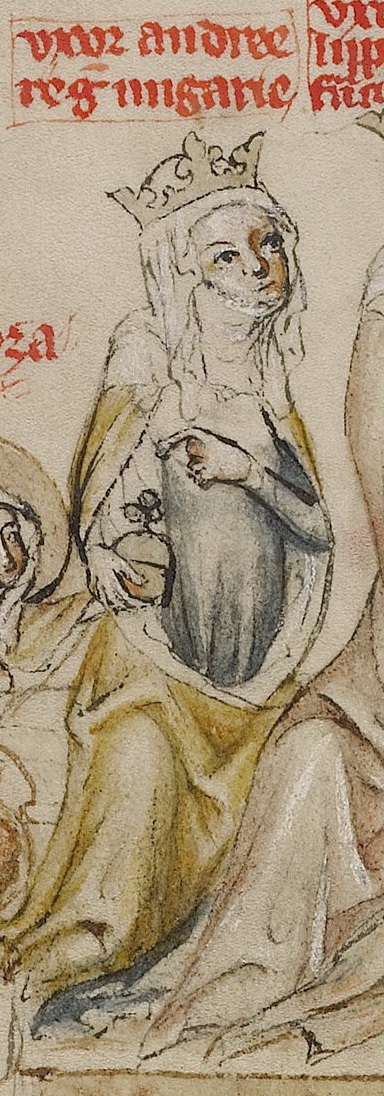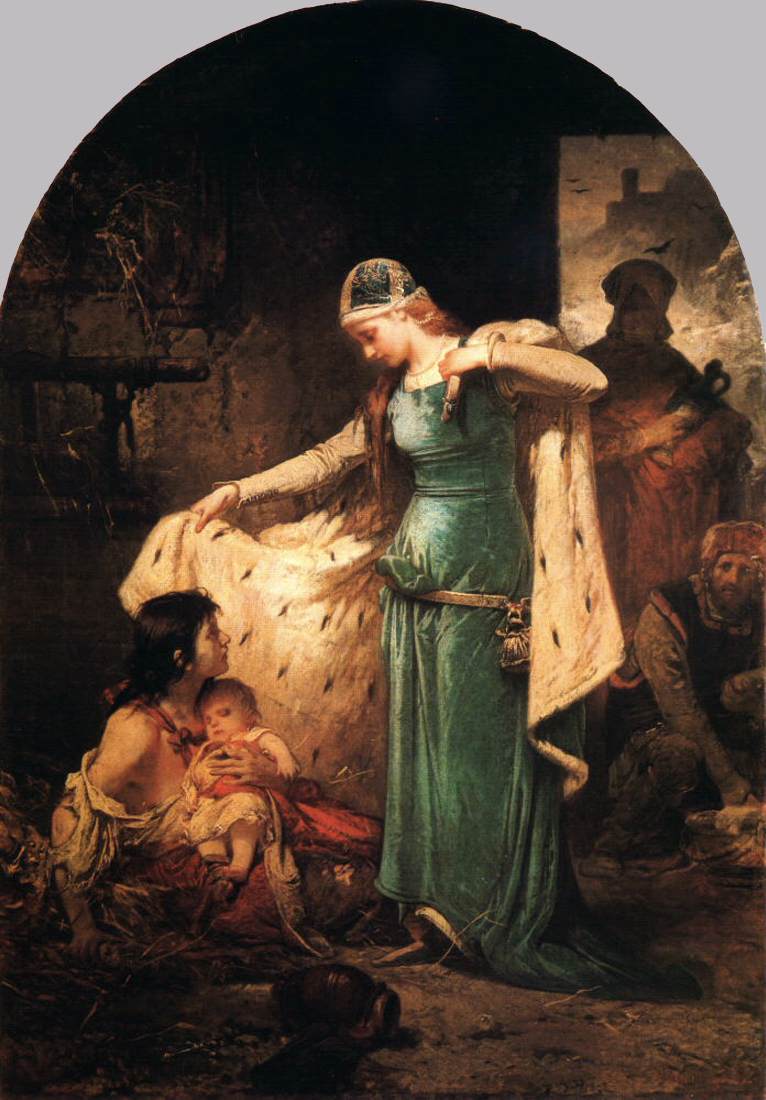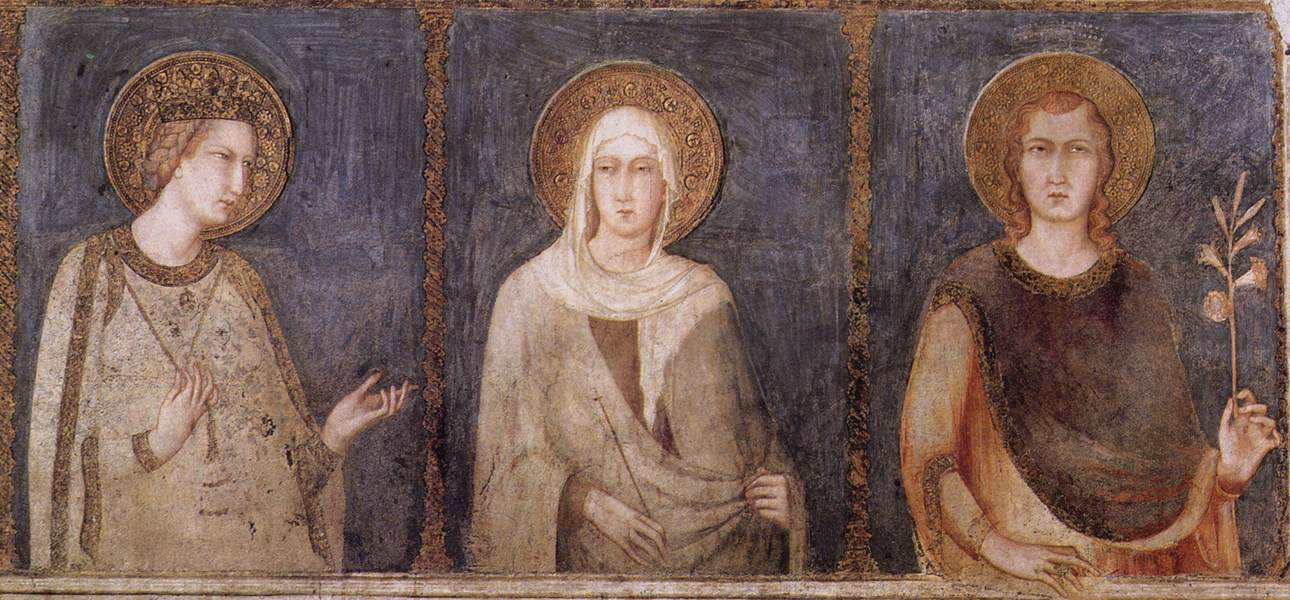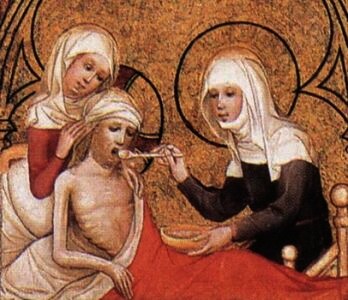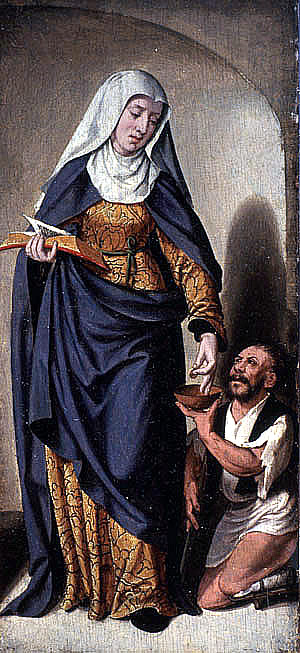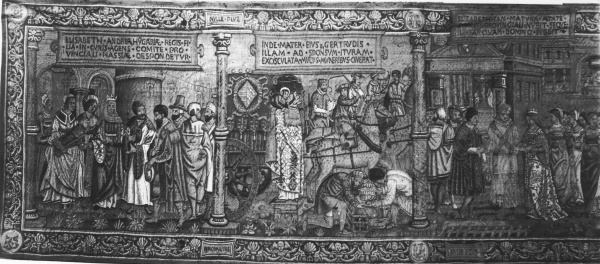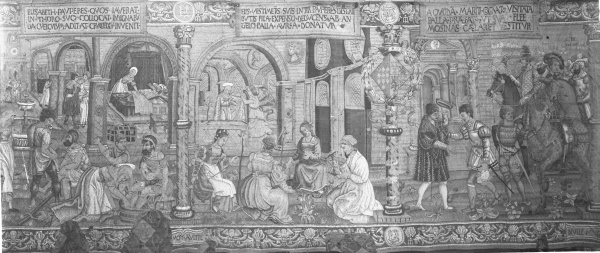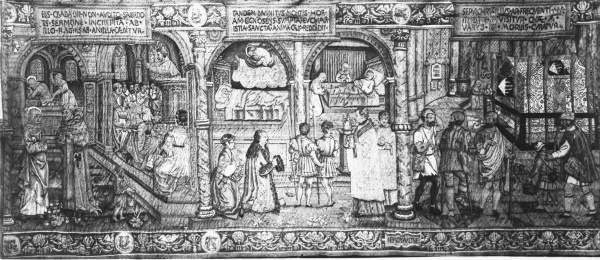Simone Martini (1285–1344)
St. Elizabeth of Hungary, c. 1322-1326
Frescoes with scenes from the life of St. Martin of Tours
Fresco
San Francesco, Lower Church
Simone Martini (1285–1344), See below
Elizabeth of Hungary, T.O.S.F., (7 July 1207 – 17 November 1231). Elizabeth was the daughter of King Andrew II of Hungary and Gertrude of Merania. Her mother's sister was St. Hedwig of Andechs, wife of Duke Heinrich I of Silesia. Her ancestry included many notable figures of European royalty, going back as far as Vladimir the Great of Kievan Rus. According to tradition, she was born in Kingdom of Hungary, on 7 July 1207.
Andrew II (1177 – 21 September 1235), also known as Andrew of Jerusalem, was King of Hungary and Croatia between 1205 and 1235.
Heroes' Square, Budapest, Hungary
Gertrude of Merania (1185 – 28 September 1213) was Queen of Hungary as the first wife of Andrew II from 1205 until her assassination.
She was regent during her husband's absence.
Muzeum Narodowe we Wrocławiu — Wrocław Workshop of the Master of the Annunciation Polyptych: Triptych of St. Hedwig, from St. Elizabeth’s Church Wrocław ~1470-1480
Through her sister Gertrude, she was the aunt of Saint Elizabeth of Hungary
Elizabeth was brought to the court of the rulers of Thuringia, in central Germany, to become betrothed to Louis IV, Landgrave of Thuringia (also known as Ludwig IV), a future union which would reinforce political alliances between the families. She was raised by the Thuringian court, so she would be familiar with the local language and culture. In 1221, at the age of fourteen, Elizabeth married Louis; the same year he was enthroned as Landgrave Louis IV. More
Piero della Francesca
St. Francis And St. Elizabeth, c. 1460
Polyptych of St. Anthony
64 x 124 cm
Galleria Nazionale dell'Umbria, Perugia
Piero della Francesca (c. 1415 – 12 October 1492) was an Italian painter of the Early Renaissance. He was also known as a mathematician and geometer. Nowadays Piero della Francesca is chiefly appreciated for his art. His painting was characterized by its serene humanism, its use of geometric forms and perspective. His most famous work is the cycle of frescoes The History of the True Cross in the church of San Francesco in the Tuscan town of Arezzo. More
In 1223, Franciscan friars arrived, and the teenage Elizabeth not only learned about the ideals of Francis of Assisi, but started to live them. Louis was not upset by his wife's charitable efforts, believing that the distribution of his wealth to the poor would bring eternal reward; he is venerated in Thuringia as a saint, though he was never canonized by the Church.
Edmund Leighton (1853–1922)
The Charity of St. Elizabeth of Hungary, c. 1895
Oil on canvas
Edmund Blair Leighton (21 September 1852 – 1 September 1922) was an English painter of historical genre scenes, specializing in Regency and medieval subjects. He was the son of the artist Charles Blair Leighton. He was educated at University College School, before becoming a student at the Royal Academy Schools. He married Katherine Nash in 1885 and they went on to have a son and daughter. He exhibited annually at the Royal Academy from 1878 to 1920.
Leighton was a fastidious craftsman, producing highly finished, decorative pictures, displaying romanticized scenes with a popular appeal. It would appear that he left no diaries, and though he exhibited at the Royal Academy for over forty years, he was never an Academician or an Associate. More
Marcos da Cruz, (1610-1683)
St. Elizabeth of Hungary
St Elisabeht washing a beggar, a scene from the main altar of St Elisabeth Cathedral in Košice, Slovakia, 2nd half of the 15th century
Elizabeth bathing the leper
Artist unknown
St. Elizabeth of Thuringia Bathes the Lepers, ca. 1480–1500
Oil painting
Another story about St. Elizabeth, also found in Dietrich of Apolda's Vita, relates how she laid the leper Helias of Eisenach in the bed she shared with her husband. Her mother-in-law, who was horrified, told this immediately to Ludwig on his return. When Ludwig removed the bedclothes in great indignation, at that instant "Almighty God opened the eyes of his soul, and instead of a leper he saw the figure of Christ crucified stretched upon the bed." This story appears in Franz Liszt's oratorio about Elizabeth.
The Holy Spirit Altarpiece, detail with the leprous Christ
In the spring of 1226, when floods, famine, and plague wrought havoc in Thuringia, Elizabeth assumed control of affairs at home and distributed alms in all parts of their territory, even giving away state robes and ornaments to the poor. Below Wartburg Castle, she built a hospital with twenty-eight beds and visited the inmates daily to attend to them.
Vincent de Groot
Elisabeth of Hungary, wearing the crown
St. Elisabeth church, Grave - Netherlands
Elizabeth's life changed irrevocably on 11 September 1227 when Louis, en route to join the Sixth Crusade, died of a fever in Otranto, Italy. On hearing the news of her husband's death, Elizabeth is reported to have said, "He is dead. He is dead. It is to me as if the whole world died today." His remains were returned to Elizabeth in 1228 and entombed at the Abbey of Reinhardsbrunn.
Marianne Stokes (1855–1927)
St Elizabeth of Hungary Spinning for the Poor, c. 1895
Oil on canvas
96.5 × 61 cm (38 × 24 in)
Marianne Stokes (1855–1927), born Marianne Preindlsberger, was an Austrian painter. She settled in England after her marriage to Adrian Scott Stokes (1854–1935), the landscape painter, whom she had met in Pont-Aven. Stokes was considered one of the leading artists in Victorian England.
Preindlsberger was born in Graz, Styria. She first studied in Munich under Lindenschmidt and having been awarded a scholarship for her first picture, Muttergluck, she worked in France under Pascal Adolphe Jean Dagnan-Bouveret (1852–1929), Colin and Gustave Courtois (1853–1923). She painted in the countryside and Paris, and, as with many other young painters, fell under the spell of the rustic naturalist Jules Bastien-Lepage. Her style continued to show his influence even when her subject matter changed from rustic to medieval romantic and biblical themes.
Her first salon painting, Reflection, which had been painted in Brittany, was exhibited in 1885 at the Royal Academy. Her work was also shown at the Grosvenor Gallery, New Gallery, and the Society of British Artists and in 1885, a year after her marriage, she took to using the name 'Mrs. Adrian Stokes'.
Together with her husband, she spent the summers of 1885 and 1886 at Skagen in the far north of Denmark where there was an artists' colony which became known as the Skagen Painters.
After abandoning oils, and inspired by the Pre-Raphaelite movement, she painted flat compositions in tempera and gesso, her paintings giving the impression of being frescoes on plaster surfaces. She was an Associate of the Royal Society of Painters in Water Colours. She died in London in August 1927. More
Sándor Liezen-Mayer (1839–1898)
Saint Elizabeth of Hungary, c. 1882
Oil on canvas, 262 x 186 cm
Magyar Nemzeti Galéria, Budapest
Sándor Liezen-Mayer (1839–1898), See below
Philip Hermogenes Calderon RA (Poitiers 3 May 1833 – 30 April 1898 London) was an English painter of French birth (mother) and Spanish (father) ancestry who initially worked in the Pre-Raphaelite style before moving towards historical genre. He was Keeper of the Royal Academy in London. More
James Collinson, British, 1825 - 1881
The Renunciation of Queen Elizabeth of Hungary, c. 1848-1850
Queen Elizabeth of Hungary was married to King Louis IV of Thuringia in 1221. After King Louis IV, her husband, died on a crusade she was deposed as regent on the grounds that she had wasted the national revenues on charity. She therefore renouced her throne and her rank, and retired to the convent of Kitzingen, where she died. Later she was canonized, and Charles Kingsley told her story in The Saint's Tragedy (1848). More
James Collinson (9 May 1825 – 24 January 1881) was a Victorian painter who was a member of the Pre-Raphaelite Brotherhood from 1848 to 1850. e was born at Mansfield, Nottinghamshire and was the son of a bookseller. He entered the Royal Academy School, and was also a fellow-student with Holman Hunt, and Dante Gabriel Rossetti.
Collinson was a devout Christian who was attracted to the devotional and high church aspects of Pre-Raphaelitism. A convert to Catholicism, Collinson reverted to high Anglicanism in order to marry Christina Rossetti, but his conscience forced his return to Catholicism and the break-up of the engagement. When Millais' painting Christ in the House of his Parents was accused of blasphemy, Collinson resigned from the Brotherhood in the belief that it was bringing the Christian religion into disrepute.
During his period as a Pre-Raphaelite, Collinson produced a number of religious works, most importantly The Renunciation of St. Elizabeth of Hungary (1850). After his resignation Collinson trained for the priesthood at a Jesuit college, but did not complete his studies.
He was secretary of the Society of British Artists from 1861 to 1870. In the latter part of his life he lived in Brittany, where he painted The Holy Family (1878). He died in April 1881. More
Following her husband's death, Elizabeth made solemn vows that included celibacy, as well as complete obedience to inquisitor Konrad von Marburg, her confessor and spiritual director. Konrad's treatment of Elizabeth was extremely harsh, and he held her to standards of behavior which were almost impossible to meet.
Philip Hermogenes Calderon 1833–1898
St Elizabeth of Hungary’s Great Act of Renunciation, c. 1891
Oil paint on canvas
Support: 1530 x 2134 mm
Tate
Among the punishments he is alleged to have ordered were physical beatings; he also ordered her to send away her three children. Her pledge to celibacy proved a hindrance to her family's political ambitions. Elizabeth was more or less held hostage at Pottenstein, Bavaria, the castle of her uncle, Bishop Ekbert of Bamberg, in an effort to force her to remarry. Elizabeth, however, held fast to her vow, even threatening to cut off her own nose so that no man would find her attractive enough to marry.
Bartolome Esteban Murillo (1617-1682)
St. Elizabeth of Hungary Tending the Sick and Leprous, circa 1671-74
Oil on canvas
Height: 325 cm (128 in). Width: 245 cm (96.5 in).
Charity Hospital, Seville
Saint Elizabeth has been greatly honoured in Spain, since the thirteenth century. Her feast was celebrated with a festive liturgy at the Cathedral of Seville and in the Cistercian Monastery of Poblet. The Saint Elizabeth cult of the Spanish people was also supported by the dynastic relations between the royal families of Aragon and Hungary. Saint Elizabeth's sister, married Jacob, King of Aragon. Their granddaughter, named after Saint Elizabeth, lived a saintly life (1271-1336) as the wife of Denis, King of Portugal. She is honoured by the Church as Saint Elizabeth of Portugal. More
Bartolomé Esteban Murillo (born late December 1617, baptized January 1, 1618 – April 3, 1682) was a Spanish Baroque painter. Although he is best known for his religious works, Murillo also produced a considerable number of paintings of contemporary women and children. His lively, realist portraits of flower girls, street urchins, and beggars constitute an extensive and appealing record of the everyday life of his times. More
Elizabeth built a hospital at Marburg for the poor and the sick with the money from her dowry, where she and her companions cared for them. Her official biography written as part of the canonization process describes how she ministered to the sick and continued to give money to the poor.
Gustave Moreau, French, 1826-1898
SAINTE ÉLISABETH DE HONGRIE OR LE MIRACLE DES ROSES, c. 1879
Rose Miracle of St. Elizabeth of Hungary
Watercolour on paper
27.5 by 19cm., 11 by 7 1/2 in.
Gustave Moreau (6 April 1826 – 18 April 1898) was a French Symbolist painter whose main emphasis was the illustration of biblical and mythological figures. As a painter, Moreau appealed to the imaginations of some Symbolist writers and artists. More
The present work encapsulates all the qualities that make Moreau’s watercolours so special: vibrant, sumptuous colours applied in an almost cloisonné technique, masterly use of the brush, delicacy of execution and fine detail. Moreau mainly used watercolour as a medium to explore the potential of colour. The stunning colour harmonies in Sainte Elisabeth de Hongrie lend this work a striking freshness. More
Rose Miracle of St. Elizabeth of Hungary
Panel painting
Elizabeth is perhaps best known for her miracle of the roses which says that whilst she was taking bread to the poor in secret, she met her husband Ludwig on a hunting party, who, in order to quell suspicions of the gentry that she was stealing treasure from the castle, asked her to reveal what was hidden under her cloak. In that moment, her cloak fell open and a vision of white and red roses could be seen, which proved to Ludwig that God's protecting hand was at work. Her husband, according to the vitae, was never troubled by her charity and always supported it. In some versions of this story, it is her brother in law, Heinrich Raspe, who questions her. Hers is the first of many miracles that associate Christian saints with roses, and is the most frequently depicted in the saint's iconography.
Sándor Liezen-Mayer (1839–1898)
Canonization of St Elisabeth of Hungary in 1235, c. 1863
Oil on canvas
Height: 62.7 cm (24.7 in). Width: 83.5 cm (32.9 in).
Hungarian National Gallery
Emperor Frederick barefoot, with the Archbishop. The emperor took off his crown and placed on Elizabeth, saing: "If I could not császárnévá crowned on the floor, take my respect as a sign that the crown who has been the kingdom of God or the Queen."
The House of Árpád fifth saint, St. Elizabeth cult rapidly spread around the world .
Sándor Liezen-Mayer (24. January 1839 in Győr ; 19th February 1898 in Munich ) was an Austrian-German painter. He attended the Academy of Fine Arts in Vienna and the Munich Academy. In 1867 he left the Academy in order to be a portrait painter. In 1870 he went to Vienna, where he painted the Emperor Franz Joseph I. and several members of the aristocracy.
In 1872 he returned to Munich. In October 1880 he accepted a position as director of the art school in Stuttgart , but returned in 1883 back to Munich, where he worked as a professor of history painting at the Art Academy until his death. More
Four scenes from the legend of St. Elizabeth of Hungary
Scenes of a farewell meeting or at a gate, a banquet with musicians, her marriage to Louis IV, Landgrave of Thuringia. Bottom right takes Saint Elisabeth farewell to a woman (her mother?) From the town of Pressburg, then they go into a chariot. At the bottom left a kneeling foundress with a rosary, c. 1500 More
Height: 82.8 cm (32.6 in) Width: 61 cm (24 in)
Rijksmuseum, Amsterdam
St. Elizabeth of Hungary
Patron Saint of Bakers, beggars; brides; charitable societies; charitable
workers; charities; countesses; death of children; diocese of Erfurt,
Germany; exiles; falsely accused people; hoboes; homeless people;
hospitals; in-law problems; archdiocese of Jaro, Philippines lacemakers;
lace workers; nursing homes; nursing services; people in exile; people
ridiculed for their piety; Sisters of Mercy; tertiaries; Teutonic Knights;
toothache; tramps; widows.
Representation, woman wearing a crown and tending
to beggars.
Opened same year as her canonization, St. Elisabeth's Church in Marburg,
the first pure Gothic edifice in Germany
Marburg was a center of the Teutonic Order, which adopted Elisabeth as its secondary patron
Workshop of Bernt Notke
Christ as the Man of Sorrows and St Elisabeth of Thüringia, 1483
Church of the Holy Spirit, Tallinn, Estonia
Master of the View of Ste-Gudule
St Catherine of Alexandria (with sword) with Sts Elizabeth of Hungary (with crown) and Dorothy (with flowers), c. 1480
Oil on panel, 45 x 47 cm
Master of the View of Ste-Gudule, Detail
I have not been able to discover the origins for the person above, embedded in the painting
This panel, depicting St Catherine of Alexandria flanked by Saint Elizabeth of Hungary and Saint Dorothy within a hortus conclusus, was formerly attributed to Martin Schongauer since the drapery and figure types are reminiscent of Schongauer's engravings. More
Master of the View of Ste-Gudule (active 1480 – 1499), was an Early Netherlandish painter. He was born in Brussels and is known for portraits of prominent church patrons and other religious works. His work is sometimes confused with that of other Antwerp or Brussels painters of his day. More
He was named after a panel in the Louvre of St Géry Preaching, which depicts in the background the façade of the cathedral church of Sainte Gudule in Brussels (later re-dedicated to St Michael).
Simone Martini (1285–1344)
St Elisabeth, St Margaret and Henry of Hungary, c. 1318
left, St. Elizabeth of Hungary, identified by her hair braid
Fresco
Height: 120 cm (47.2 in). Width: 228 cm (89.8 in).
Lower Church, San Francesco
Simone Martini (c. 1284 – 1344) was an Italian painter born in Siena. He was a major figure in the development of early Italian painting and greatly influenced the development of the International Gothic style.
It is thought that Martini was a pupil of Duccio di Buoninsegna, the leading Sienese painter of his time. According to late Renaissance art biographer Giorgio Vasari, Simone was instead a pupil of Giotto di Bondone, with whom he went to Rome to paint at the Old St. Peter's Basilica, Giotto also executing a mosaic there. Martini's brother-in-law was the artist Lippo Memmi. Very little documentation of Simone's life survives, and many attributions are debated by art historians. More
Workshop Master of Elsloo; ca 1520-1530
Saint Elisabeth van Thüringen
Oak;
Height 100 cm
Unknown Artist
St. Elizabeth; Clothes the Poor and Tends the Sick, c, 1390
Sebastiano Ricci
St. Elizabeth Of Hungary
Sebastiano Ricci (1 August 1659 – 15 May 1734) was an Italian painter of the late Baroque school of Venice. About the same age as Piazzetta, and an elder contemporary of Tiepolo, he represents a late version of the vigorous and luminous Cortonesque style of grand manner fresco painting. More
Barthel Bruyn the Elder
Saint Catherine
Bartholomäus Bruyn (1493–1555), usually called Barthel Bruyn or Barthel Bruyn the Elder, was a German Renaissance painter active in Cologne. He painted altarpieces and portraits, and was Cologne's foremost portrait painter in the sixteenth century. More
St. Catherine's Church in Hoogstraten: Tapestry of St. Elizabeth of Hungary: First carpet: Engagement, Wedding and Goodbye
St. Catherine's Church in Hoogstraten: Tapestry of St. Elizabeth of Hungary: Second carpet: Humility, Charity, Hospitality
St. Catherine's Church in Hoogstraten: Tapestry of St. Elizabeth of Hungary: Third carpet: Penance, Death and the visit to the grave
Images are copyright of their respective owners, assignees or others
Acknowledgement: Wikipedia,


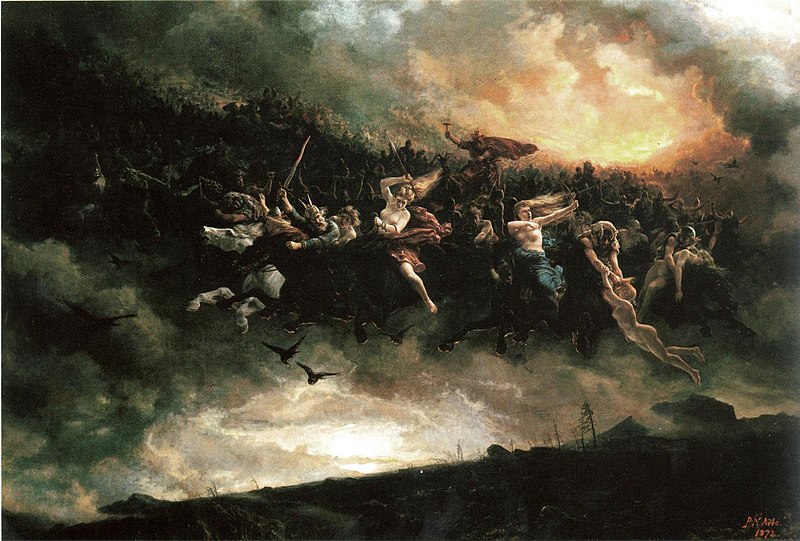













.jpeg?1384210217)


